The Best Architectural Sites to Explore in Ireland

News
News
News
News
This piece is brought to you in partnership with Tourism Ireland.
Ireland is rich in architectural history and styles. No visit to the Emerald Isle would be complete without seeing some of these wonders for yourself.
From ancient ruins to modern masterpieces, Ireland’s architectural sites offer a captivating journey through the land’s history and culture. Here are 10 of Ireland’s best architectural marvels to explore across the island.
Prehistoric Tombs at Brú na Bóinne
Newgrange, a prehistoric passage tomb located on the UNESCO World Heritage Site of Brú na Bóinne in County Meath, was constructed over 5000 years ago. That makes it older than Stonehenge and the Pyramids of Giza! This remarkable structure holds great significance as it’s considered one of the most significant Neolithic-era sites in the world, showcasing an extensive collection of megalithic art in Western Europe, just an hour’s drive from Dublin.
Newgrange is famous for its detailed stone carvings and connection to the winter solstice sunrise. Every year, a few lucky visitors can witness a breathtaking spectacle at this precise spot when an awe-inspiring ray of light illuminates the entire chamber during the solstice. The exterior of the 80-metre mound is supported by kerb stones engraved with spirals and white Wicklow quartzite. Inside the passage tomb, you’ll pass through standing stones decorated with spiraling Megalithic rock art before carefully crawling under wooden beams to enter the cross-shaped chamber where the solstice sunbeam puts on its annual show.
Brú na Bóinne has more to explore beyond Newgrange. Knowth and Dowth, built around 3200 BC, are also passage tombs in the area. Knowth’s Great Mound is comparable to Newgrange and is accompanied by 18 smaller mounds. It boasts two passages with entrances on opposite sides, and interestingly, the eastern passage is adorned with carvings that are thought to represent lunar maps. Dowth, known as the “Fairy Mound of Darkness,” is similar in size to Newgrange and Knowth, and its south chamber is a ligned with the setting sun on the winter solstice.

Ancient Hill Forts in the Aran Islands
The Aran Islands are home to many ancient hill forts, including Dún Aonghasa on Inis Mór. It’s the perfect spot for a day trip and only a simple ferry ride from Doolin or Galway. The fort is about 6 kilometres from Kilronan, the main town on Inis Mór, so visitors can either rent a bike or take the scenic walk to the site.
Dún Aonghasa, also known as Dun Aengus, is a stone ring fort — or rath — with a history dating back over 3000 years. Archaeological digs have revealed evidence of prehistoric metalwork, homes, and burial sites at this site. It was refortified in AD 700–800.
The largest ring fort in the Aran Islands, Dún Aonghasa, sits proudly on the edge of a cliff overlooking the Atlantic Ocean, towering 87 meters above the seal. This remarkable fort boasts three impressive drystone defense walls, encircled by a dense cluster of thousands of sharp, upright stones known as a chevaux-de-frise. And if the fort happens to look familiar to you, it’s because it was seen in the 2022 film, The Banshees of Inisherin, starring Colin Farrell, Brendan Gleeson and Barry Keoghan.

A Historic Monastery and Bell Tower in Glendalough
Nestled in Wicklow Mountains National Park in Ireland’s Ancient East is Glendalough, which translates to “valley of the two lakes.” It was here that St. Kevin established a monastery in the 6th century, which became a prominent hub of knowledge during the Early Christian era in Ireland.
The Round Tower of Glendalough is the most famous attraction in the area, standing 33 meters tall. Built by the monks of St. Kevin’s monastery almost a millennium ago, it had its roof replaced in 1876 due to a lightning strike. The tower — also called a “Cloigtheach” or bell tower — not only offered refuge to the monks but also acted as a lookout and guiding light for those approaching the monastery.
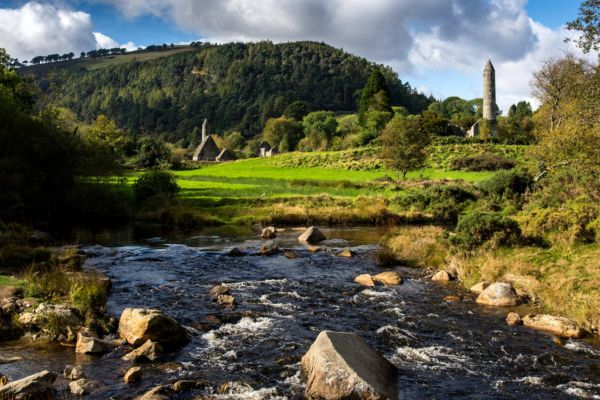
A Famous Monastery and Nunnery in Clonmacnoise
Once a leading centre of religion and learning in Europe, Clonmacnoise, in County Offaly, dates back to 545 AD. Established by St. Ciarán, it is located at the intersection of the River Shannon and Ireland’s primary east-west passageway at the time, the Eiscir Riada (Esh-cur Ree-ada). By the 9th century, it was Ireland’s most famous monastery, attracting scholars from across the continent. During the 9th to 11th centuries, it served as a burial ground for the High Kings of Tara.
Here, you’ll have the opportunity to discover the circular tower, three magnificent high crosses, seven churches, gravestones and the ruins of a grand cathedral. A short walk from the main area is the Nun’s Church, showcasing the unique Hiberno-Romanesque style seen in Ireland and serving as the location of the Clonmacnoise nunnery. And don’t forget to admire the beautiful chancel arch and entrance, which features a Sheela-na-gig carving on one of the voussoirs of the chancel arch.
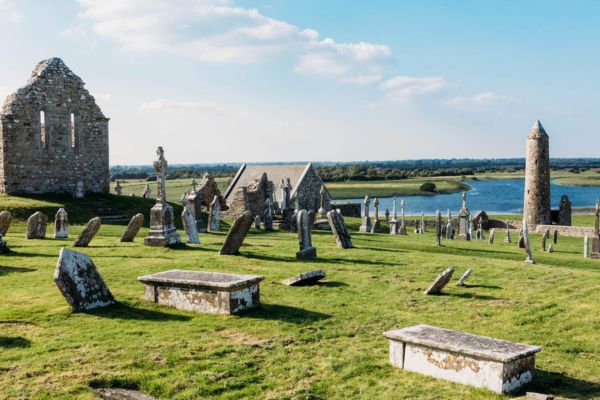
Quintessential Thatched Cottages Around the Island
One of Ireland’s most iconic symbols, the traditional thatched cottage with whitewashed walls, reaches back in history to the ancient crannóg and one-roomed labourers’ cottages. Even though they only represent a small fraction of all housing in Ireland today, back in the 1800s, up to half of the population had cottages with thatched roofs. Visitors to Ireland can step into the past by staying in one of these quaint structures, whether you choose one of the cottages dottedalong the coastline of the Wild Atlantic Way, inland in the quaint village of Adare in County Limerick or on the tranquil shores of Lough Keenagh in County Fermanagh.
Building materials used for cottages changed as time went on and varied depending on the region and the family’s financial status. Lime mortar was the preferred option for walls, despite being expensive. An alternative was a mixture of mud with added strengthening components such as straw, reeds, or animal materials. Roofs were typically made by stacking sod on the timber frame, with thatchers skillfully adding straw thatch made from wheat and flax in either a sliced or sketched pattern. Completing a single roof could require as many as 5,000 handfuls of straw.
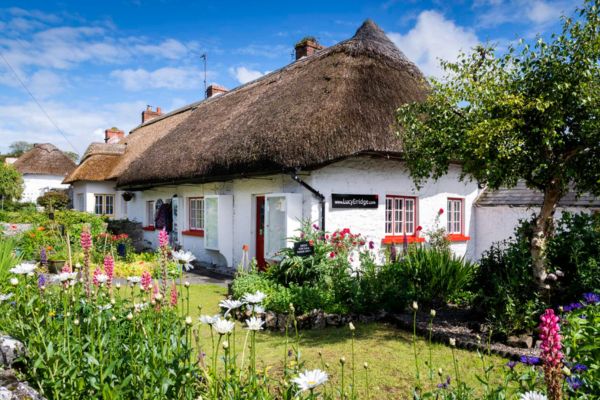
Ancient Ruins at Dunluce Castle
Located at the edge of a basalt outcropping on the coastal cliffs of northern County Antrim, about an hour from Belfast, Dunluce Castle is one of the most striking sites in Ireland. Built by the MacQuillians in the 15th century, Dunluce witnessed upheaval, violence, and rebellion. In the 1550s, the MacDonnell clan took control of the castle, led by the infamous warrior chieftain Sorely Boy MacDonnell. By the 17th century, it became the seat of the Earls of Antrim, and Dunluce Town was built nearby.
You can explore the archaeological excavations of the deserted Dunluce Town and listen to stories about the eventful night in 1639 when the castle kitchens plunged into the sea. The kitchen remains perfectly preserved beside the manor house, showcasing the oven, fireplace, and entrances.
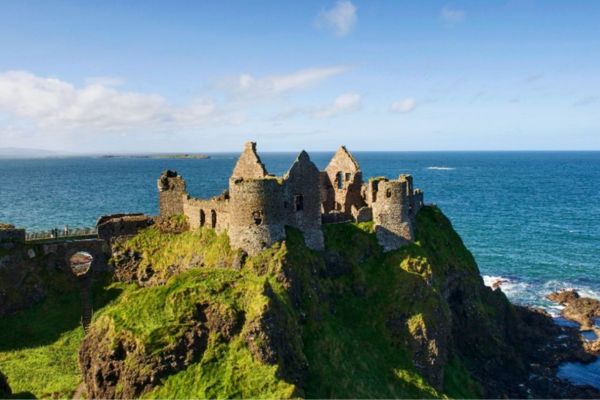
Underground Tunnels and a Magical Stone at Blarney Castle
Blarney Castle, constructed almost six centuries ago by the renowned Irish chieftain Cormac MacCarthy, is famous for the enchanted stone that bestows upon those who kiss it the gift of eloquence and charm. (Or, as the Irish say, “The gift of the gab”)
Hidden in the Cork countryside, the partial ruin is full of mysteries waiting to be uncovered. Beneath the surface lies a complex system of underground tunnels dating back to the Middle Ages. While many of these passageways are restricted, you can venture into the haunting dungeon where prisoners were once confined. Ascend the stone steps to the battlements at the castle’s highest point for breathtaking views of the surrounding landscape. Stop by the Blarney Stone itself or admire the watchtower, standing tall and keeping an eye on the castle grounds.
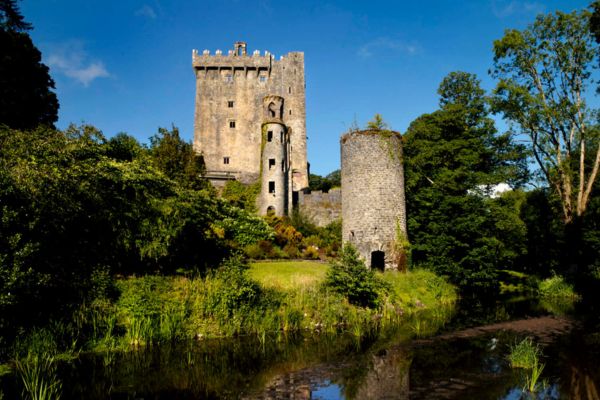
Medieval Military History at Carrickfergus Castle
A Norman structure in Northern Ireland’s County Antrim, Carrickfergus Castle has stood over Belfast Lough for over 800 years. John de Courcy built Carrickfergus in 1177 as his base of operations following his successful conquest of eastern Ulster. Until 1204, he held the position of petty king but was then overthrown by Hugh de Lacy, another Norman adventurer.
Despite facing attacks from the Scots, Irish, English and French throughout its history, Carrickfergus has managed to withstand the test of time. It played a crucial military role until 1928 and remains one of the most well-preserved medieval structures in Ireland. What sets it apart is that it is the only castle of its age that is open to the public, allowing visitors to step back in time and experience its rich history firsthand.
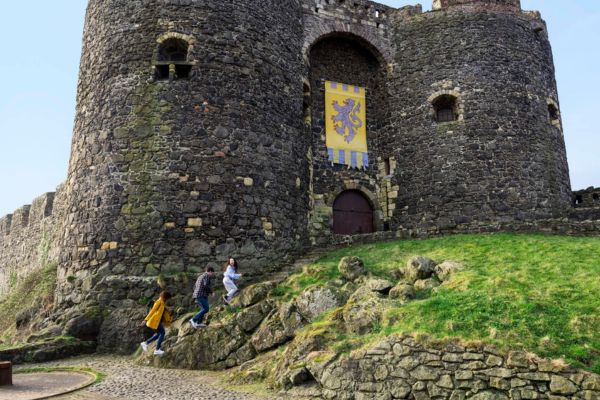
A Stroll Across the Ha’Penny Bridge
The Ha’penny Bridge, also referred to as the Penny Ha’penny Bridge — and officially known as the Liffey Bridge — is a charming pedestrian bridge that was constructed in May 1816 over the River Liffey in Dublin, Ireland. Crafted from cast iron in Shropshire County, England, it is one of the first structures of its kind.
Before the elliptical arch bridge was built, ferries were used to cross the river at the cost of a ha’penny, or a halfpenny. When the bridge replaced boats, pedestrians paid a ha’penny toll to cross it, which is the origin of its moniker. It was the only pedestrian bridge to span the river until the Millennium Bridge opened in 1999. The bridge spans 43 metres across the Liffey and an average of 30,000 people cross it each day.

A Handshake Across the Water at the Peace Bridge
The Peace Bridge, located in Derry-Londonderry, stands as a powerful symbol of peace within the city, narrating a tale of overcoming challenges and bridging the gap between the two banks of the River Foyle.
AECOM, the designer of the Sutong Yangtze River Bridge in China, collaborated with Wilkinson Eyre Architects, the designer of the Gateshead Millennium Bridge over the River Tyne in England, to create the impressive 235-meter bridge. The bridge features two structural arms extending in opposite directions, representing the coming together of the Protestant Waterside and the Nationalist Bogside communities on either side of the Foyle. These once separate arms now join in a symbolic handshake over the river.
Designed for cyclists and pedestrians, it officially opened on June 25, 2011, and is the newest addition to the three bridges spanning the River Foyle. It serves as a vital link between Ebrington Square and the bustling city centre and is just a short stroll from the Guildhall and the city’s iconic walls.
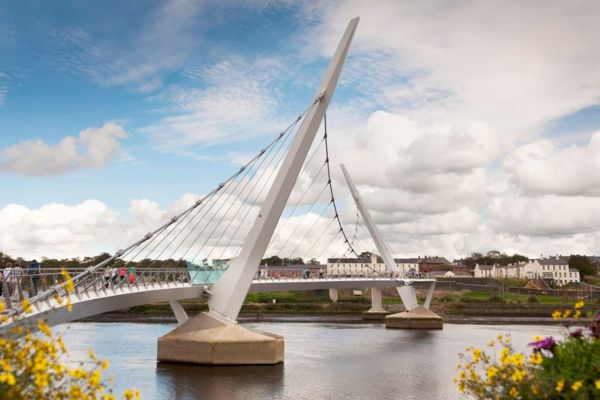
Immerse yourself in Ireland’s awe-inspiring architectural landscape and vibrant history. Fill your heart with Ireland and visit Ireland.com to plan your next Irish adventure today.
